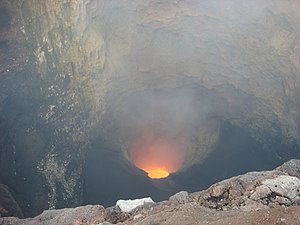Lava lake
A lava lake is an accumulation of liquid lava in a depression, usually a volcanic crater . Sometimes the term is also applied to a frozen lava lake. If the lava is located in a volcanic crater with a direct supply of the lava from below, this is referred to as a primary lava lake , whereas if the lake was fed by above-ground inflows, it is referred to as a secondary lava lake .
Most active lava lakes are composed of basaltic melt, except for Mount Erebus , which contains a phonolithic melt.
behavior
The rising red-hot lava begins to cool immediately when it reaches the surface and forms a thin black crust. Since this crust becomes heavier than the hotter liquid lava, it is swallowed again immediately, which has already been compared with the subduction in plate tectonics . If the supply of fresh magma or hot gases is greater, the lake, or parts of it, begins to boil violently, up to the point of ejection of slag and bombs .
Many of the currently active lava lakes have been active for a long time, but the height of the lava level can vary greatly. Sometimes the lake can overflow, as is often the case at Kīlauea and is rather harmless. At Nyiragongo in 1977 a crack opened in the crater rim and the lava lake ran out. The fast flowing lava flow claimed 600 lives.
Examples
The Kīlauea volcano in Hawaii has repeatedly produced lava lakes in various craters. The last major event with the sinking and refilling of the lava lakes in the Puʻu ʻŌʻō and Halemaʻumaʻu craters took place in March 2011. Their lava levels are currently fluctuating considerably.
Active lava lakes
There are currently (as of 2015) only a few active lava lakes on earth.
Africa
- Erta Ale (Ethiopia): 80 m × 90 m diameter, active since 1906
- Nyiragongo (Virunga National Park, Congo): intermittently active since 1977
Antarctic
- Mount Erebus (Antarctica): 60 mx 45 m, active since at least 1972
Atlantic Ocean
- Holuhraun lava field ( Bárðarbunga , Iceland): 400 m × 100 m, active since October 2014
Middle and South America
- Masaya (Nicaragua):
- Villarrica (Chile): intermittently active since 2009
Pacific Ocean
- Puʻu-ʻŌʻō -crater ( Kīlauea , Hawaii ): since 1987 intermittent lava lakes
- Halemaʻumaʻu crater (Kīlauea, Hawaii): active since 2008, its lava level fluctuates around 90 m
- Ambrym (Vanuatu): Crater of the (Mbwelesu-) Marum
- Ambrym (Vanuatu): Benbow crater
Halemaʻumaʻu : crater with lava lake (Hawaii, 2016)
Erta Ale : Lava lake in a pit crater (Ethiopia, 2001)
Ambrym : Lava Lake (Vanuatu, 2009)
Halemaʻumaʻu: Time-lapse image of the lava lake in the crater (Hawaii, 2016)
Frozen lava lakes
Several solidified lava lakes can be found in the Fort Rock Basin , in the US state of Oregon, within Pleistocene tuff rings . Also at Dimmuborgir Lake Myvatn in northern Iceland is the remains of a solidified lava.
More recent examples can be found at Kilauea, where, among other things, the Kīlauea-Iki crater was filled in by a 116 m lava flow in 1959 and then slowly solidified. This is also an example of a secondary lava lake . In this lava lake, among other things, the temperature profile and the magmatic differentiation during the solidification process could be observed and analyzed through drilling . It took almost 400 days at the Alae lava lake , which is only 20 m deep , until it completely solidified and the temperature fell below 1000 ° C, the solidus temperature of basalt.
Alien lava lakes
Active lava lakes are suspected to be active in several volcanic craters on Jupiter's moon Io . Examples are Loki Patera and Tupan Patera .
literature
- Peter Francis, Clive Oppenheimer: Volcanoes . Oxford University Press, Oxford 2004, ISBN 0-19-925469-9 , p. 116.
Web links
Photos and videos
Other
- USGS Glossary entry (English)
- www.xflo.net, April 2010, Florian Wizorek: Continental drift in miniature - The lava lake of Erta Ale Called on June 5, 2010 18:37 CEST
Individual evidence
- ↑ Summary of Historical Eruptions, 1750 - Present
- ^ The 1924 explosions of Kilauea.
- ↑ Pu`u `Ō` ō crater floor collapse followed by middle east rift zone eruption. March 5, 2011.
- ↑ Recent Kilauea Status Reports, Updates, and Information Releases. December 14, 2014, accessed December 15, 2014 .
- ↑ Ambrym.
- ↑ Hans Pichler, Thomas Pichler: volcanic areas of the earth . Spektrum Akademischer Verlag, Heidelberg 2007, ISBN 978-3-8274-1475-5 , p. 170
- ↑ Hans-Ulrich Schmincke: Vulcanism . Primus-Verlag, Darmstadt 2010, ISBN 978-3-89678-690-6 , p. 28.









